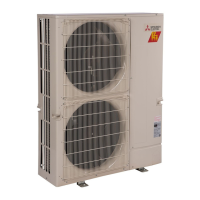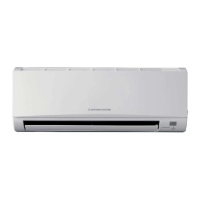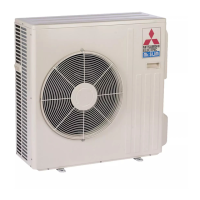107
Phenomena
Factor
Countermeasure
2. Remote controller display works
normally and the unit performs
heating operation, however, the
capacity cannot be fully obtained.
1 Linear expansion valve fault
Opening cannot be adjusted well due to linear
expansion valve fault.
2 Refrigerant shortage
3 Lack of insulation for refrigerant piping
4 Filter clogging
5 Heat exchanger clogging
6 Air duct short cycle
7 Bypass circuit of outdoor unit fault
1 Discharging temperature and indoor heat
exchanger temperature does not rise.
Inspect the failure by checking discharg-
ing pressure.
Replace linear expansion valve.
2 If refrigerant leaks, discharging tempera-
ture rises and LEV opening increases.
Inspect leakage by checking the tem-
perature and opening.
Check pipe connections for gas leakage.
3 Check the insulation.
4 Open intake grille and check the filter.
Clean the filter by removing dirt or dust
on it.
5 If the filter is clogged, indoor pipe tem-
perature rises and discharging pressure
increases. Check if heat exchanger is
clogged by inspecting discharging pres-
sure.
Clean the heat exchanger.
6 Remove the blockage.
7 Check refrigerant system during opera-
tion.
3.1 For 3 minutes after temperature
adjuster turns off, the compres-
sor will not start operating even if
temperature adjuster is turned on.
2 For 3 minutes after temperature
adjuster turns on, the compressor
will not stop operating even if tem-
perature adjuster is turned off.
(Compressor stops operating
immediately when turning off by
the remote controller.)
1 2 Normal operation
(For protection of compressor)
1 2 Normal operation
1. Remote controller display works
normally and the unit performs cool-
ing operation, however, the capacity
cannot be fully obtained. (The air
does not cool well.)
1 Refrigerant shortage
2 Filter clogging
3 Heat exchanger clogging
4 Air duct short cycle
1 If refrigerant leaks, discharging tempera-
ture rises and LEV opening increases.
Inspect leakage by checking the tem-
perature and opening.
Check pipe connections for gas leakage.
2 Open intake grille and check the filter.
Clean the filter by removing dirt or dust
on it.
3 If the filter is clogged, indoor pipe tem-
perature rises and discharging pressure
increases. Check if heat exchanger is
clogged by inspecting discharging pres-
sure.
Clean the heat exchanger.
4 Remove the blockage.
8-4. TROUBLESHOOTING BY INFERIOR PHENOMENA
4. The compressor that is running
soon after powered on is slow to
speed up.
The rate of speed-up is kept at 2 Hz/ min. during 4
hours after powered on.
This can prevent a compressor failure that occurs when
a non-energized compressor speeds up rapidly with
refrigerant collected in the compressor.
Normal operation

